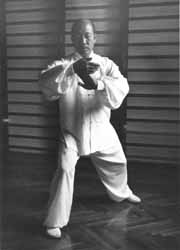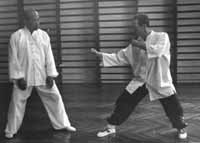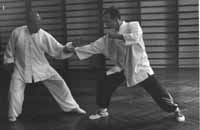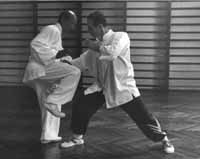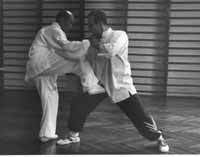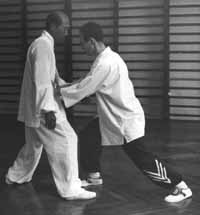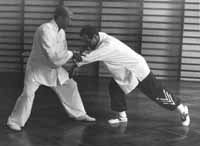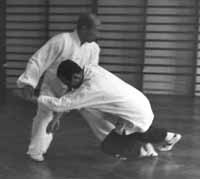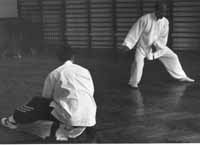Taijiquan > Taijiquan and the Qi Connection
Taijiquan and the Qi Connection
By Howard Choy
Whenever I introduce Taijiquan and Qigong to a new audience, invariably I am asked the question, "What is the difference between Taijiquan and Qigong?" I would go through with my audience a list of attributes for Taijiquan and then Qigong. We would look at the similarities and the differences between the two and then arrive at the simple conclusion that Taijiquan is a form of Qigong with self-defence applications. So far, so good . . . until I was asked the follow-up question, "Is Kung Fu also a form of Qigong then?" "Yes," I would reply. "All Chinese martial arts are forms of Qigong. As a matter of fact, at the highest level there are no differences between Kung Fu, Taijiquan and Qigong." By then everyone is confused.
I think the confusion comes about because our Western logic teaches us that if A is A, then A cannot be A + B at the same time. We tend to compartmentalise things that we have to do or to learn intellectually. There is no place for integrated thinking. Specialisation is the order of the day. It is not uncommon for some teachers to advise their students not to study Taijiquan and Kung Fu at the same time. They say that one is an internal art and the other is an external art and that the two just don't mix. We now have Kung Fu tournaments as distinct from Internal Arts tournaments. Guoshu is considered to be real Kung Fu while Wushu is not. Meditation is not Kung Fu and Chen style Taijiquan is not the same Taijiquan as Yang style Taijiquan and so forth. What a misunderstanding of the essence of Chinese martial arts and the diversity of its expressions!
Take Taijiquan as case in point. From its humble beginnings in the Chenjiaguo Village, we now have a large variety of family and "official government" styles, as well as a distinct separation between what Tung Ying-chieh would have termed the martial and civil accomplishments of Taijiquan .
To quote a passage from Tung's Secret Method as translated by Douglas Wile: "In Tai Chi Chuan, the ability to cultivate oneself physically and spiritually, but not to defend oneself, is civil accomplishment. The ability to defend oneself but not to cultivate oneself is martial accomplishment." He goes on to say, "The ability to teach people the art of self-cultivation and self-defence, both cultivation and application, is complete civil and martial Tai Chi."
Instead of integrating the martial and civil components of Taijiquan we now have teachers who specialise in Taijiquan as fighting art, or as a health and healing exercise, or Taijiquan as a philosophy and a way of life. They don't understand or refuse to acknowledge that Taijiquan in its complete form is an integration of self-defence, self knowledge and self well-being.
It is good business to advertise: "Real Taijiquan is declining because real Taijiquan is about fighting and no-one knows how to fight with Taijiquan anymore except me". Or, "Real Taijiquan is about self-enlightenment. We can show you the way because our teacher is a Taoist Monk and we teach Taoist Taijiquan". In this way, Taijiquan is simplified and made into a clear image of black and white to sell to the gullible public. It is a gross misrepresentation of Taijiquan, not unlike trying to draw the Yin/Yang diagram with a straight line through the middle. The straight line divides the circle into two separate halves instead of holding it together with dynamic tension as would an 'S' line through the middle.
What is this force that holds the opposites together in dynamic tension? I got my answer when I once asked my teacher, Master Chen Xiao-wang, "What is the essence of Taijiquan?" I was expecting a complex answer. Instead, he simply said, "It is all about the interaction of Yin and Yang and Qi circulation." He said that Qi, our vital force, is a bit like electricity. It requires a polarity of negative and positive, or Yin and Yang dynamics for it to flow. The movements of Taijiquan, if executed properly, with correct breath and mind intent, will provide the polarities to activate and to maintain qi flow to nourish our body and our mind. Illnesses result from qi blockages and qi deficiency, which Taijiquan can prevent from happening. The Seven Emotions will affect our health and well-being because they are also forms of qi blockage. Unless we gain control of our qi circulation, we have no hope of being healthy, let alone being enlightened.
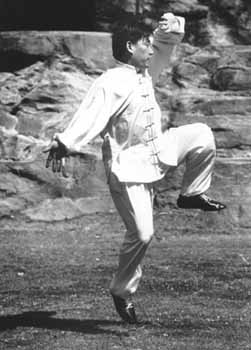
Master Chen Xiaowang
"What about self-defence with Taijiquan?" I asked. He said that to fight is to let loose a series of concentrated doses of your qi. Fajing is an explosion of qi flow. In Taijiquan, you don't pre-plan your fight, you react to your opponent's attack with an air of relaxed mindfulness. The Classic says, "Where the mind goes, qi will follow and action results. "Fear and tension will hinder our qi flow. We need to remain relaxed and loose at all times, as we struggle with our opponent. Without warning, my teacher proceeded to strike my head with his palm. Without thinking, I blocked him with my arm held upward. He smiled and said, "There you are, 'White Crane spreads its Wings!"
The next obvious question is: "How do you gain this Qi connection and Qi circulation?" Again he replied succinctly: "By getting the feel of it first." He said that the reason we repeat the Taijiquan movements slowly and deliberately, over and over again, is so we can feel the qi on our body gradually. We do Push Hands with each other so our qi can be put under pressure to test its connections (Peng jing). If our posture is out of alignment, our qi will break and we will be pushed over. If we lose our concentration or lose the feeling of the connection of qi in our body, we will be "penetrated" and be pushed over also. We perceive and react to the outer world through our five senses. Without feeling, or the awareness of qi in us, we are not really alive.
|
|
|
|
Press jing |
Peng jing |
One simple way to get in touch with our qi is to do "Zhan Zhuang", or "to stand like a stake". One of the earliest references to Zhan Zhuang appeared in the ancient Taoist Classic, the Tao Teh Ching: Standing alone and unchanging, One can observe every mystery, Present at every moment and Ceaselessly continuing - This is the gateway to indescribable marvels.
As a matter of fact, Taijiquan is full of Zhan Zhuang postures. For example, the first movement, Taijiquan Preparation, is in fact the same as Wuji Zhuang. You simply stand with your legs apart at shoulder width, and slowly cultivate your qi in the dantian area. While standing, you should adhere to all the Taijiquan principles such as: Keep the energy at the top of the head light and sensitive. Sink the chest and raise the back. Relax the waist. Distinguish full and empty. Sink the shoulders and drop the elbows. Use the mind and not the strength. Unite the upper and lower body and unite the internal and external, and so forth. After standing still for five to ten minutes, you will begin to feel blockage and confused patterns of qi in your body. You will feel pain in certain parts of your body and the boredom may drive you crazy. If you persevere and make adjustments by following the task of observing your posture, observing your breath and observing your mind consciously, you will slowly feel a sense of fullness of qi in your dantian. After you learn to adjust your posture, adjust your breath and adjust mind accordingly, your qi will then gradually spread out to the rest of your body as you keep up your practice.
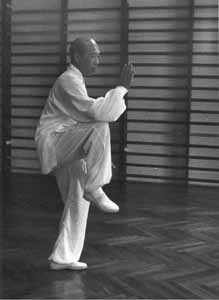
The posture of Golden Cock Stands, with the application shown below:
|
|
|
|
|
|
The end result is a highly energised body whose structure can be likened to a three-dimensional bicycle wheel. The hub of the wheel is your lower dantian, with your qi spreading out to the perimeter of the wheel, that is body, limbs and extremities, and connected to the centre of millions of qi sprockets. It is important that you remain centred at all times, otherwise the qi sprockets will break and your wheel will collapse into a heap as you move from one posture to another (metaphorically speaking). You can practice Taijiquan form as through it is a series of Zhan Zhuang potures joined together to ensure that your qi stays together and centred throughout the form.
Another simple exercise you can do to improve your qi flow is the Reeling Silk Jiabenggong with one or two hands. In Master Chen Xiao-wang's Taijiquan class, he always starts with half an hour of Zhan Zhuang, followed by 20 or 30 repetitions of the various Jiabenggong exercises. He says that after nearly 40 years of practice, he still does his Jiabenggong each day, especially when he is too busy to go through the forms.
In the final analysis, this essence of Taijiquan lies in Qi circulation and Qi utilisation. We lose balance in Push Hands because our qi is broken or out of alignment. Jing, or dynamic force, comes about when our qi is full and connected. When you have Jing, no-one can push you over. The more your qi is connected, the more Jing you have. When our qi is connected, we can use it to fight (as in using Peng jing and Faijing to push your opponent) and we can also use it for health benefit. This is where the martial and civil components of Taijiquan come together to make us an integrated and wholistic human being.
The application of Lu jing in Yang family Taijiquan:
|
|
|
|
|
|
All photos courtesy of my Polish Taijiquan students. My thanks to their efforts and entusiasm.



